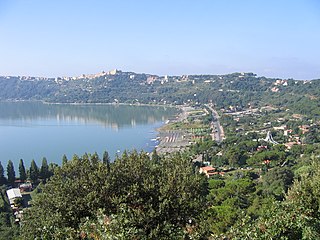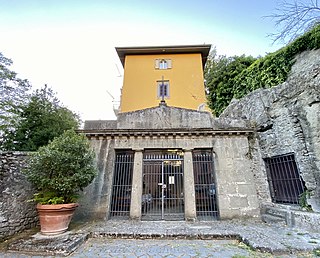
The Colosseum is an elliptical amphitheatre in the centre of the city of Rome, Italy, just east of the Roman Forum. It is the largest ancient amphitheatre ever built, and is still the largest standing amphitheatre in the world, despite its age. Construction began under the Emperor Vespasian in 72 and was completed in AD 80 under his successor and heir, Titus. Further modifications were made during the reign of Domitian. The three emperors who were patrons of the work are known as the Flavian dynasty, and the amphitheatre was named the Flavian Amphitheatre by later classicists and archaeologists for its association with their family name (Flavius).

Castel Gandolfo, colloquially known as Castello in the Castelli Romani dialects, is a town located 25 km (16 mi) southeast of Rome, in the Italian region of Lazio. Situated on a hilltop in the Alban Hills with panoramic views of Lake Albano, Castel Gandolfo is home to approximately 8,900 residents and is renowned as one of Italy's most scenic towns. It is one of I Borghi più belli d'Italia.

Albano Laziale is a comune (municipality) in the Metropolitan City of Rome Capital, on the Alban Hills, in the Italian region of Lazio. Rome is 25 kilometres (16 mi) distant. It is bounded by other communes of Castel Gandolfo, Rocca di Papa, Ariccia and Ardea. Located in the Castelli Romani area of Lazio. It is sometimes known simply as Albano.

Lake Albano is a small volcanic crater lake in the Alban Hills of Lazio, at the foot of Monte Cavo, 20 km (12 mi) southeast of Rome. Castel Gandolfo, overlooking the lake, is the site of the Papal Palace of Castel Gandolfo.

The Ludus Magnus, also known as the Great Gladiatorial Training School, was the largest of the gladiatorial schools in Rome. It was built by the emperor Domitian in the late first century C.E., alongside other building projects undertaken by him such as three other gladiatorial schools across the Roman Empire.

Roman amphitheatres are theatres — large, circular or oval open-air venues with tiered seating — built by the ancient Romans. They were used for events such as gladiator combats, venationes and executions. About 230 Roman amphitheatres have been found across the area of the Roman Empire. Early amphitheatres date from the Republican period, though they became more monumental during the Imperial era.

The Archaeological Park of Urbs Salvia is situated in the comune of Urbisaglia, in the Marches, Italy. It is the largest archaeological park in the region.

The Castra Albana was an ancient Roman legionary fortress of the Legio II Parthica founded by the Emperor Septimius Severus (193–211) on the site of the present Albano Laziale.

The Tours amphitheater is a Roman amphitheatre located in the historic city center of Tours, France, immediately behind the well known Tours cathedral. It was built in the 1st century when the city was called Caesarodunum. It was built atop a small hill on the outskirts of the ancient urban area, making it safe from floods, convenient for crowds and visitors, and demonstrating the power of the city from a distance. The structure was an enormous, elliptical structure approximately 122 meters by 94 meters. According to its design it is classified as a "primitive" amphitheatre. Unlike the famous Colosseum that was made mostly of masonry and built above-ground, the Tours amphitheatre was made mostly of earth and created by moving soil and rock into a bowl shape. Spectators likely sat directly on the grassy slopes, while the masonry was primarily used for the vomitoria and retaining walls.

The Villa of Domitian, known as Albanum Domitiani or Albanum Caesari in Latin, was a vast and sumptuous Roman villa or palace built by emperor Domitian. It was situated 20 km (12 mi) from Rome, high in the Alban Hills where summer temperatures are more comfortable. It faced west overlooking the sea and Ostia. To travellers on the via Appia it would have made an impressive sight.

The Roman amphitheatre of Syracuse is one of the best preserved structures in the city of Syracuse, Sicily, from the early Imperial period.

The Amphitheatre of Catania is a Roman amphitheatre in Catania, Sicily, Southern Italy, built in the Roman Imperial period, probably in the 2nd century AD, on the northern edge of the ancient city at the base of the Montevergine hill. Only a small section of the structure is now visible, below ground level, to the north of Piazza Stesicoro. This area is now the historic centre of the city, but was then on the outskirts of the ancient town and also occupied by the necropolis of Catania. The structure is part of the Parco archeologico greco-romano di Catania.

The sanctuary of Santa Maria dell'Acquasanta or Acqua Santa is a place of Catholic Marian worship in the city of Marino, in the Roman Castles area, in the metropolitan city of Rome Capital and suburbicarian diocese of Albano. It is currently included in the parish of the basilica of San Barnaba.

Palazzo Pamphilj is a historical palace in the city of Albano Laziale, in the province of Rome, in the Roman Castles area.

The sanctuary of Maria Santissima della Rotonda, formerly known as Santa Maria Maggiore, is an important Marian sanctuary in Lazio, located in the city of Albano Laziale, in the province of Rome, in the Roman Castles area.
The history of the city of Marino, in the province of Rome, in the Roman Castles area, begins with the appearance of the first human settlements in the municipal territory during the Bronze Age. In the Middle Ages the castle knew its period of greatest splendor under the rule in turn of the Counts of Tusculum, the Frangipane, the Orsini, the Apostolic Chamber, the Caetani, and finally the Colonna, of whom it was a historic stronghold. Marinese events have often been of considerable importance in the local and sometimes even international historical context, so much so that various scholars in various eras have tried their hand at collecting the historical memories of this town. The castle was besieged several times, with mixed results, suffering at least four sackings and two destructions a fundamentis. However, the feudal lords and the community have been concerned at all times to erect monuments for public ornament, such as the only example of Gothic architecture in the Roman Castles, the former church of Santa Lucia, the sanctuary of Santa Maria dell'Acquasanta, the Frangipane and Orsini fortresses, Palazzo Colonna, the collegiate basilica of San Barnaba, Palazzo Matteotti, and many other public works. Numerous important personalities in politics, the arts, religion, and finance were also born, lived, or related in some way in Marino.

The church of Santa Maria ad Nives of Palazzolo is a Catholic place of worship located in the municipality of Rocca di Papa, in the province of Rome, in the suburbicarian diocese of Frascati. Next to the church stands the former convent of the Friars Minor Observant.

The Greek Theatre of Cyrene was the largest and oldest of the five known theatres in Cyrene, Libya. It was built on the north slope of the Acropolis, west of the Sanctuary of Apollo and was originally built as a standard Greek theatre, probably in the late sixth century BC. The structure underwent several phases of renovation and was eventually converted into a Roman amphitheatre in the second century AD.
The historic centre of Albano Laziale corresponds to the territory of the first municipal decentralization district of the municipality of the same name of Albano Laziale, in the province of Rome, Lazio.

The Pontifical Villas of Castel Gandolfo are buildings erected in an area of about 55 hectares located in the Roman Castles, in the Metropolitan City of Rome Capital, included among the extraterritorial areas of the Holy See in Italy.

















